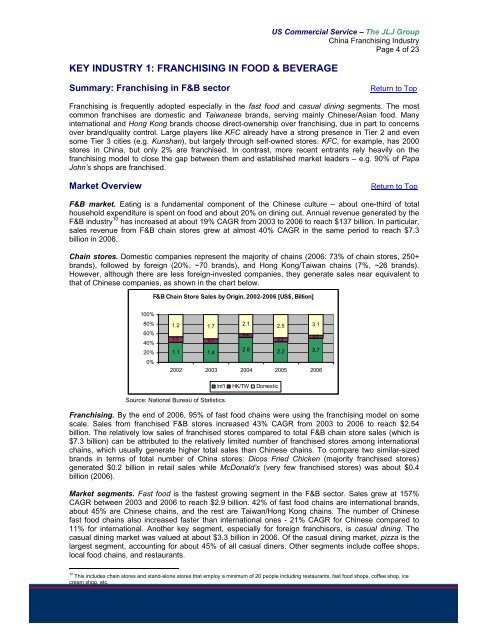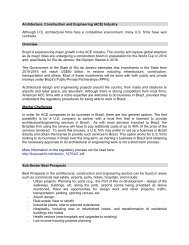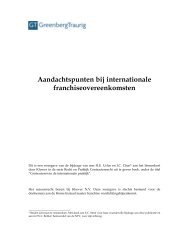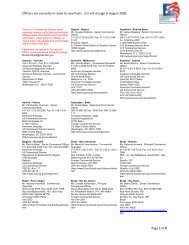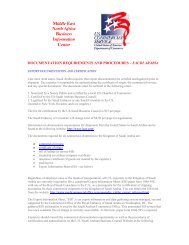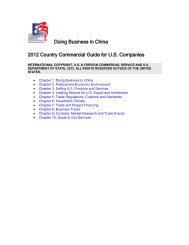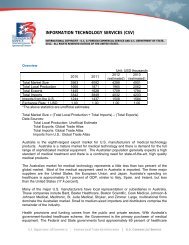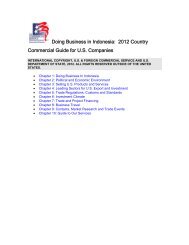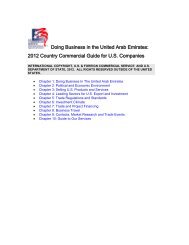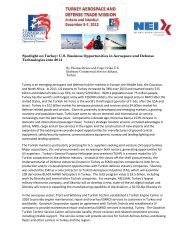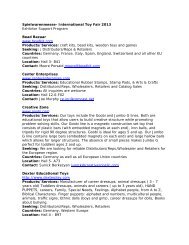CHINA: Franchising Industry - Export.gov
CHINA: Franchising Industry - Export.gov
CHINA: Franchising Industry - Export.gov
You also want an ePaper? Increase the reach of your titles
YUMPU automatically turns print PDFs into web optimized ePapers that Google loves.
KEY INDUSTRY 1: FRANCHISING IN FOOD & BEVERAGE<br />
US Commercial Service – The JLJ Group<br />
China <strong>Franchising</strong> <strong>Industry</strong><br />
Page 4 of 23<br />
Summary: <strong>Franchising</strong> in F&B sector Return to Top<br />
<strong>Franchising</strong> is frequently adopted especially in the fast food and casual dining segments. The most<br />
common franchises are domestic and Taiwanese brands, serving mainly Chinese/Asian food. Many<br />
international and Hong Kong brands choose direct-ownership over franchising, due in part to concerns<br />
over brand/quality control. Large players like KFC already have a strong presence in Tier 2 and even<br />
some Tier 3 cities (e.g. Kunshan), but largely through self-owned stores. KFC, for example, has 2000<br />
stores in China, but only 2% are franchised. In contrast, more recent entrants rely heavily on the<br />
franchising model to close the gap between them and established market leaders – e.g. 90% of Papa<br />
John’s shops are franchised.<br />
Market Overview Return to Top<br />
F&B market. Eating is a fundamental component of the Chinese culture – about one-third of total<br />
household expenditure is spent on food and about 20% on dining out. Annual revenue generated by the<br />
F&B industry 10 has increased at about 19% CAGR from 2003 to 2006 to reach $137 billion. In particular,<br />
sales revenue from F&B chain stores grew at almost 40% CAGR in the same period to reach $7.3<br />
billion in 2006.<br />
Chain stores. Domestic companies represent the majority of chains (2006: 73% of chain stores, 250+<br />
brands), followed by foreign (20%, ~70 brands), and Hong Kong/Taiwan chains (7%, ~26 brands).<br />
However, although there are less foreign-invested companies, they generate sales near equivalent to<br />
that of Chinese companies, as shown in the chart below.<br />
100%<br />
80%<br />
60%<br />
40%<br />
20%<br />
0%<br />
F&B Chain Store Sales by Origin, 2002-2006 [US$, Billion]<br />
1.2<br />
0.3 0.3<br />
1.1<br />
1.7<br />
1.4<br />
2.1<br />
0.4<br />
2.8<br />
2002 2003 2004 2005 2006<br />
Source: National Bureau of Statistics.<br />
Int'l HK/TW Domestic<br />
<strong>Franchising</strong>. By the end of 2006, 95% of fast food chains were using the franchising model on some<br />
scale. Sales from franchised F&B stores increased 43% CAGR from 2003 to 2006 to reach $2.54<br />
billion. The relatively low sales of franchised stores compared to total F&B chain store sales (which is<br />
$7.3 billion) can be attributed to the relatively limited number of franchised stores among international<br />
chains, which usually generate higher total sales than Chinese chains. To compare two similar-sized<br />
brands in terms of total number of China stores: Dicos Fried Chicken (majority franchised stores)<br />
generated $0.2 billion in retail sales while McDonald’s (very few franchised stores) was about $0.4<br />
billion (2006).<br />
Market segments. Fast food is the fastest growing segment in the F&B sector. Sales grew at 157%<br />
CAGR between 2003 and 2006 to reach $2.9 billion. 42% of fast food chains are international brands,<br />
about 45% are Chinese chains, and the rest are Taiwan/Hong Kong chains. The number of Chinese<br />
fast food chains also increased faster than international ones - 21% CAGR for Chinese compared to<br />
11% for international. Another key segment, especially for foreign franchisors, is casual dining. The<br />
casual dining market was valued at about $3.3 billion in 2006. Of the casual dining market, pizza is the<br />
largest segment, accounting for about 45% of all casual diners. Other segments include coffee shops,<br />
local food chains, and restaurants.<br />
10<br />
This includes chain stores and stand-alone stores that employ a minimum of 20 people including restaurants, fast food shops, coffee shop, ice<br />
cream shop, etc.<br />
2.5<br />
0.5<br />
2.2<br />
3.1<br />
0.5<br />
3.7


